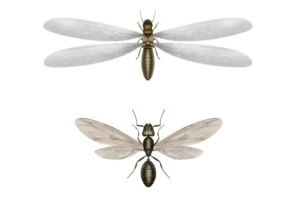Termites or Ants – How to Tell the Difference
Proudly Serving South Carolina | North Carolina | Georgia | Florida

It’s an important distinction: ants versus termites. One is a minor nuisance; the other is a serious pest issue that can cause major damage to your home if left unchecked. Termite damage is no joke – it’s estimated these tiny pests are responsible for up to $5 billion in damages to American homes annually. The good news is that termite damage happens slowly over time. If you act at the first sign of termites, you can often avoid the worst of it. So it’s time for a quick refresher course on how to tell termites apart from ants.
Can You Tell the Difference Between an Ant and a Termite by Looking at It?
Yes, you just have to know what to look for. There are some clear physical differences between ants and termites that can help you identify which pest you’re dealing with. Here are three key features to pay attention to:

- Waist: One of the most noticeable differences is the waist. Ants have a pinched waist that makes their bodies look segmented. Termites have thicker bodies overall with a broad waist. If you see an insect with a defined, hourglass figure, it’s likely an ant. If the body is more straight and cylindrical, it’s probably a termite.
- Color: Color can also be a distinguishing factor. Ants are usually darker in color, often black or dark brown. Termites are usually lighter, often white or pale brown. If you spot a small insect with a pale, almost translucent body, you’re likely looking at a termite rather than an ant.
- Antenna: Finally, take a close look at the antennae. Ants have elbowed antennae, meaning they bend like a human elbow. Termite antennae are straight, looking almost like a string of tiny pearls.
Start With A Quote On Us
Click below to contact Rocket Pest for a FREE pest control quote.
Termites or Flying Ants?
What if you see one of these pests with wings? Does that automatically mean it’s a termite? Not necessarily. Both termites and ants develop wings during their breeding phases, making it tricky to tell them apart at a glance. However, their wings do have some notable differences that can help you identify them:
- Size of Wings: Both have two pairs of wings. Termites’ two sets are disproportionately large and of equal length. Ants have front wings that are longer than their back wings. Their wings appear proportionate to their body size.
- Piles of Wings: Termite wings are more fragile and brittle than those of ants. They shed their wings easily, especially after swarming. So if you find piles of wings near windowsills, doorways, or other entry points in your home, you’re likely dealing with termites.
Termite Damage Versus Ant Damage
When it comes to the damage these pests cause, the stakes are much higher with termites. While ants are more of an annoyance, termites can wreak havoc on the structural integrity of your home. That said, there’s one exception to the rule: carpenter ants.
Carpenter ants, unlike other ants, can cause significant damage as well, but their destruction is different from that of termites. Here are the key differences:
Termite Damage
- Termites eat wood, leaving behind hollowed-out areas in structures, blistering, or a honeycomb appearance in wood.
- Termite damage is often found in hidden, hard-to-reach areas, making early detection difficult without professional inspection.
- Damage can go unnoticed until it becomes severe.
Carpenter Ant Damage
- Carpenter ants don’t eat wood like termites do. Instead, they tunnel through it to create nests called “galleries.” Compared to termites, carpenter ant tunneling is smoother and cleaner.
- Unlike termites, carpenter ants prefer moist, decaying wood, so their damage is often found in areas where moisture has already weakened the wood.
For more information on carpenter ants, be sure to check out our article >> How to Identify Wood Destroying Ants
If It’s Termites, Don’t Wait!
Now that you know how to tell the difference between ants and termites, it’s important to plan your next steps. If you suspect termites, don’t wait to take action. We strongly recommend calling our professional termite exterminators right away. Some homeowners try store-bought options to see if they can take care of the problem themselves, but this often gives termites crucial time to become established, making it a more complicated and costly problem than it would have been.
Don’t let termites (or ants) threaten your home. Our termite control and ant control experts will be happy to get you started with a thorough inspection and treatment plan tailored to your needs. Call us now for a free estimate.
Back to Termite Control